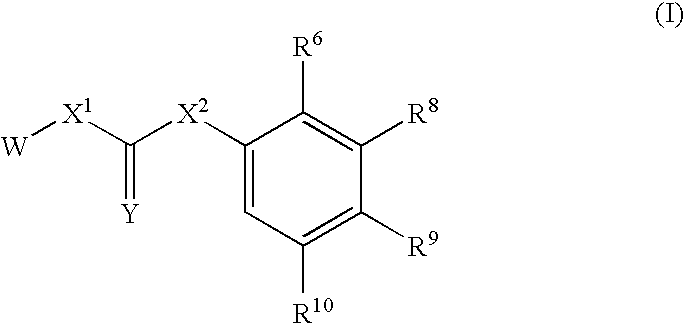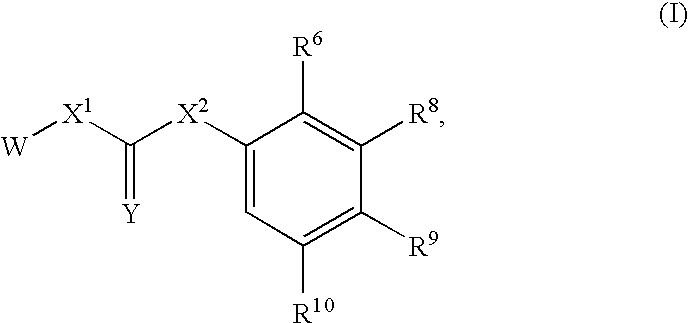Compounds useful for inhibiting CHK1
a technology of compounds and compounds, applied in the field of compounds, can solve the problems of affecting the treatment effect of aberrant cell proliferation, inappropriate cell proliferation, and unwanted repair,
- Summary
- Abstract
- Description
- Claims
- Application Information
AI Technical Summary
Benefits of technology
Problems solved by technology
Method used
Image
Examples
example 1
Determination of IC50 Values of the Chk1 Inhibitors
[0206]Human Chk1 cDNA was identified and cloned as described previously in WO 99 / 11795, filed Sep. 4, 1998. A FLAG® tag was inserted in frame with the amino terminus of the full-length Chk1. The 5′ primer contains an EcoRI site, a Kozak sequence, and also encodes a FLAG® tag for affinity purification using the M2 Antibody (Sigma, Saint Louis, Ill.). The 3′ primer contains a SalI site. The PCR-amplified fragment was cloned into pCI-Neo as an EcoRI-SalI fragment (Invitrogen, Carlsbad, Calif.), then subcloned as an EcoRI-NotI fragment into pFastBacI (Gibco-BRL, Bethesda, Md.). Recombinant baculovirus was prepared as described in the Gibco-BRL Bac-to-Bac manual and used to infect Sf-9 cells grown in CCM3 medium (HyClone Laboratories, Logan, Utah) for expression of FLAG®-tagged Chk1 protein.
[0207]FLAG®-tagged Chk1 was purified from frozen pellets of baculovirus-infected SF9 cells. Frozen cell pellets were mixed with an equal volume of 2×...
example 2
Selectivity
[0209]Chk1 inhibitors of the present invention were tested for selectivity, with Chk1 as the comparison enzyme and the following protein kinases as comparator enzymes: Cdc2, Chk2, CTAK, EphA1, EphA2, Erk1, FGFR1, FGFR4, IR, JNK1, c-Kit, p38alpha, p38beta, p38delta, Ros, Rse, Rsk2, TrkA, TrkB, protein kinase A, protein kinase C, pp60v-src, protein kinase B / Akt-1, p38MapK, p70S-6K, calcium calmodulin-dependent kinase II, and ab1 tyrosine kinase.
[0210]The IC50 value of a compound versus Chk1 was measured as described above. The IC50 value of the compound against comparator enzymes was measured using the SelectSmart™ (MDS Pharma Servies, Bothell, Wash., USA) proprietary technology platform with either a modified ELISA procedure or fluorescence polarization. All inhibitors tested showed at least a 20-fold selectivity for Chk1 over the tested comparator enzymes.
[0211]Alternatively, assays for determining IC50 for each of these kinases have been previously described in the liter...
example 3
Chk1 Inhibitors of the Invention Inhibit Chk1 Function in Cells
[0212]To establish that the Chk1 inhibitors of the invention inhibit Chk1 function in cells, inhibitors can be tested in molecular cell-based assays. Because mammalian Chk1 has been shown to phosphorylate Cdc25C in vitro, suggesting that it negatively regulates cyclin B / cdc2 in response to DNA damage, the ability of the Chk1 inhibitors to enhance the activity of CyclinB / cdc2 can be analyzed. The experiment can be designed as follows: HeLa cells are irradiated with 800 rads and incubated for 7 h at 37° C. Because these cells are functionally p53 negative, they arrest exclusively in G2. Then, nocodazole is added to a concentration of 0.5 μg / mL and the cells are incubated for 15 h at 37° C. The addition of nocodazole is designed to trap any cells that progress through the G2 arrest into M. Finally, a Chk1 inhibitor is added for 8 h, the cells harvested, lysed and immunoprecipitated equal amounts of protein with an antibody ...
PUM
| Property | Measurement | Unit |
|---|---|---|
| temperature | aaaaa | aaaaa |
| temperature | aaaaa | aaaaa |
| temperatures | aaaaa | aaaaa |
Abstract
Description
Claims
Application Information
 Login to View More
Login to View More - R&D
- Intellectual Property
- Life Sciences
- Materials
- Tech Scout
- Unparalleled Data Quality
- Higher Quality Content
- 60% Fewer Hallucinations
Browse by: Latest US Patents, China's latest patents, Technical Efficacy Thesaurus, Application Domain, Technology Topic, Popular Technical Reports.
© 2025 PatSnap. All rights reserved.Legal|Privacy policy|Modern Slavery Act Transparency Statement|Sitemap|About US| Contact US: help@patsnap.com



